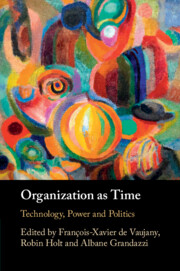Book contents
- Organization as Time
- Organization as Time
- Copyright page
- Contents
- Figures
- Tables
- Contributors
- Organization as Time
- Part I The Politics of Time: Ontologies and Metaphysics of Organization as Time
- Part II Re-orienting Critique in Organization Studies? Exploring Jointly Time and Politics
- Part III New Ways of Organizing Work, Digitality and the Politics of Time
- 9 ‘Working the Time’
- 10 Temporal Structures of Telework in Public Sector Organizations
- 11 Towards a Processual Understanding of Buildings
- 12 The Temporality of Entrepreneurship
- 13 Management as Dramatic Events
- Part IV History and Duration: Making Things Last, Enduring Politics and Organizing
- Index
- References
10 - Temporal Structures of Telework in Public Sector Organizations
from Part III - New Ways of Organizing Work, Digitality and the Politics of Time
Published online by Cambridge University Press: 22 June 2023
- Organization as Time
- Organization as Time
- Copyright page
- Contents
- Figures
- Tables
- Contributors
- Organization as Time
- Part I The Politics of Time: Ontologies and Metaphysics of Organization as Time
- Part II Re-orienting Critique in Organization Studies? Exploring Jointly Time and Politics
- Part III New Ways of Organizing Work, Digitality and the Politics of Time
- 9 ‘Working the Time’
- 10 Temporal Structures of Telework in Public Sector Organizations
- 11 Towards a Processual Understanding of Buildings
- 12 The Temporality of Entrepreneurship
- 13 Management as Dramatic Events
- Part IV History and Duration: Making Things Last, Enduring Politics and Organizing
- Index
- References
Summary
In this chapter we explore the multi-temporalities and organisational challenges that emerge in telework adopted by public sector organizations, looking at how temporal structures from office and home eventually collide. We interviewed 32 civil servants from six different Brazilian public sector organizations that freely opted to work at home in a pre-pandemic period. Our findings reveal contradictions related to how teleworkers perceive temporal structures shaping their daily activities in home office. Such contradictions emerge as temporal structures from office and home may not allow accommodation, mainly for synchronous tasks.
- Type
- Chapter
- Information
- Organization as TimeTechnology, Power and Politics, pp. 211 - 228Publisher: Cambridge University PressPrint publication year: 2023

